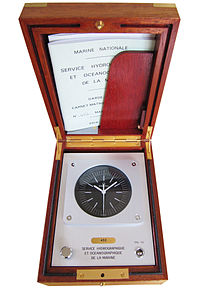This article includes a list of general references, but it lacks sufficient corresponding inline citations. (June 2013) |


Longitude by chronometer is a method, in navigation, of determining longitude using a marine chronometer, which was developed by John Harrison during the first half of the eighteenth century. It is an astronomical method of calculating the longitude at which a position line, drawn from a sight by sextant of any celestial body, crosses the observer's assumed latitude.[1] In order to calculate the position line, the time of the sight must be known so that the celestial position i.e. the Greenwich Hour Angle (Celestial Longitude - measured in a westerly direction from Greenwich) and Declination (Celestial Latitude - measured north or south of the equational or celestial equator), of the observed celestial body is known. All that can be derived from a single sight is a single position line, which can be achieved at any time during daylight when both the sea horizon and the sun are visible. To achieve a fix, more than one celestial body and the sea horizon must be visible. This is usually only possible at dawn and dusk.
The angle between the sea horizon and the celestial body is measured with a sextant and the time noted. The Sextant reading is known as the 'Sextant Altitude'. This is corrected by use of tables to a 'True Altitude'. The actual declination and hour angle of the celestial body are found from astronomical tables for the time of the measurement and together with the 'True Altitude' are put into a formula with the assumed latitude. This formula calculates the 'True Hour Angle' which is compared to the assumed longitude providing a correction to the assumed longitude. This correction is applied to the assumed position so that a position line can be drawn through the assumed latitude at the corrected longitude at 90° to the azimuth (bearing) on the celestial body. The observer's position is somewhere along the position line, not necessarily at the found longitude at the assumed latitude. If two or more sights or measurements are taken within a few minutes of each other a 'fix' can be obtained and the observer's position determined as the point where the position lines cross.
The azimuth (bearing) of the celestial body is also determined by use of astronomical tables and for which the time must also be known.
From this, it can be seen that a navigator will need to know the time very accurately so that the position of the observed celestial body is known just as accurately. The position of the sun is given in degrees and minutes north or south of the equational or celestial equator and east or west of Greenwich, established by the English as the Prime Meridian.
The desperate need for an accurate chronometer was finally met in the mid 18th century when an Englishman, John Harrison, produced a series of chronometers that culminated in his celebrated model H-4 that satisfied the requirements for a shipboard standard time-keeper.
Many nations, such as France, have proposed their own reference longitudes as a standard, although the world’s navigators have generally come to accept the reference longitudes tabulated by the British. The reference longitude adopted by the British became known as the Prime Meridian and is now accepted by most nations as the starting point for all longitude measurements. The Prime Meridian of zero degrees longitude runs along the meridian passing through the Royal Observatory at Greenwich, England. Longitude is measured east and west from the Prime Meridian. To determine "longitude by chronometer," a navigator requires a chronometer set to the local time at the Prime Meridian. Local time at the Prime Meridian has historically been called Greenwich Mean Time (GMT), but now, due to international sensitivities, has been renamed as Coordinated Universal Time (UTC), and is known colloquially as "zulu time".
- ^ Basic Principles of Marine Navigation by D A Moore Published by Kandy p89